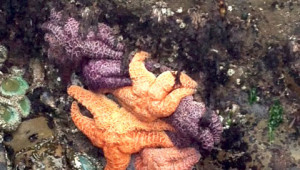A group of students from The Branson School have been monitoring key invertebrates and species of algae at Duxbury Reef in Bolinas, California for roughly 10 years. This January, we found some unexpected things. We saw an octopus, a rare sighting!
The octopus in question was an East Pacific Red Octopus, or Octopus rubescens. Like many octopuses, the Red Octopus has an amazing ability to camouflage, and is able to alter both the color and texture of its skin. We were able to experience its incredible camouflage ability first hand; the octopus first mimicked coralline algae, turning itself a reddish pink, and adopted a bumpy texture, executing a near-flawless impression of the algae. Later, after moving from the side of the pool to the floor, it turned a dark brown, in order to match the rocky substrate at the bottom of the pool.
Another interesting thing about the monitoring was the fact that no one in our group saw a single sea star. Sea stars are a common staple of intertidal life at Duxbury, so this blatant lack of sea stars was not only unusual, but also very concerning.


































